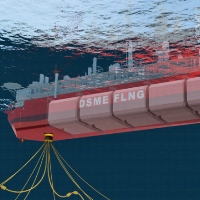Joint Development Programme
 Class society ABS and Korea’s Daewoo Shipbuilding & Marine Engineering (DSME) are concluding a one-year joint development programme (JDP) examining critical wave conditions for sloshing model tests and computational fluid dynamics (CFD) in the cargo tanks of floating liquefied natural gas (FLNG) vessels. The results will offer the industry a new methodology to determine critical sloshing conditions more efficiently than in the past.
Class society ABS and Korea’s Daewoo Shipbuilding & Marine Engineering (DSME) are concluding a one-year joint development programme (JDP) examining critical wave conditions for sloshing model tests and computational fluid dynamics (CFD) in the cargo tanks of floating liquefied natural gas (FLNG) vessels. The results will offer the industry a new methodology to determine critical sloshing conditions more efficiently than in the past.
Also, the methodology promises to be valuable in reducing the cost and time duration for sloshing test campaigns. Designing for sloshing impact loads is a key concern in tank containment system design. As the cargo tanks have increased in size along with various filling conditions for offshore FLNG operations, the possibility of severe sloshing becomes more likely as well as the probability of structural damage to the containment system. The new ABS-DSME methodology is being proposed as a pre-screening procedure for selecting the most severe critical sea states before the start of a sloshing model test or sloshing flow simulation.
“Model tests can not cover all possible wave height, period, heading and filling levels since there are just too many combinations to determine the life time maximum sloshing loads,” observes Yung Sup Shin, Head of the Containment System Group, ABS Corporate Technology. “However, we have developed a robust way to determine a finite number of critical sloshing conditions consistently and efficiently compared to other existing methods.”
The methodology, explains Shin, consists of two main steps. A sloshing pseudo-response amplitude operator (RAO) is defined based on the total sloshing wave energy and, secondly, the concept of sloshing severity is introduced based on the area under the sloshing energy response spectrum curve. This highly advanced theoretical formulation represents ship motion and sloshing interaction calculating the energy of the liquid cargo in the tank. The numerical analysis of the fluid motion from this theoretical methodology has been validated by comparing the results to those from conventional sloshing tests for an FLNG cargo tank.






